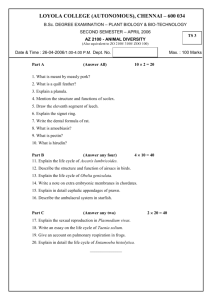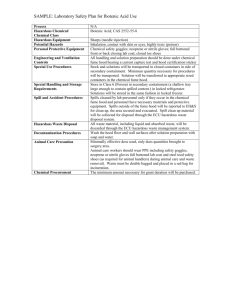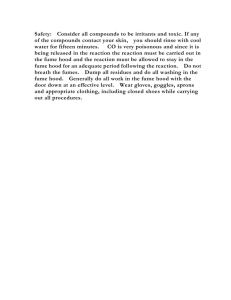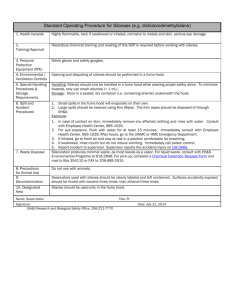Tour of Building 2100 Biological Sciences
advertisement
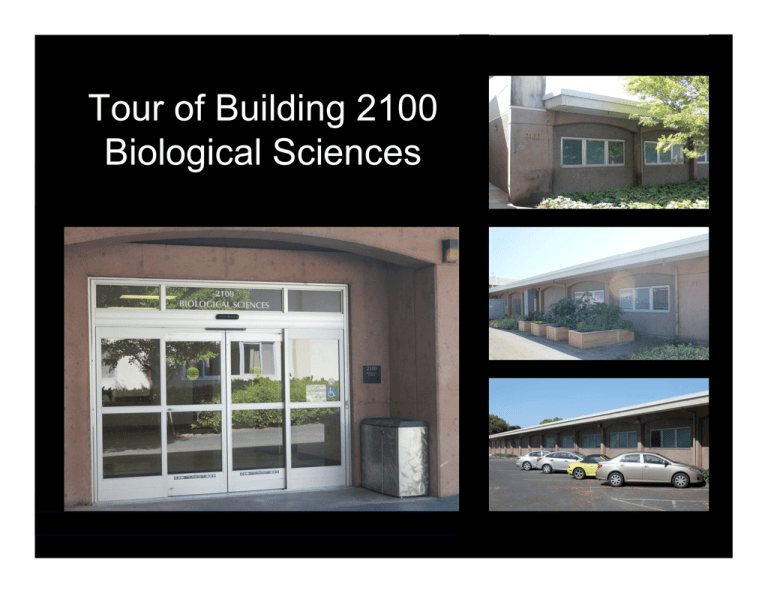
Tour of Building 2100 Biological Sciences Building 2100 was constructed in 1965 1965 - First commercial scanning electron microscope 1966 - Genetic code cracked 1967 - First human heart transplant 1968 - First successful bone marrow transplant 1969 - First moon walk 1970 - First vaccine developed for rubella 1971 - Discovery of RNA priming in DNA synthesis 1972 - First successful DNA cloning experiments 1973 - First successful recombinant DNA experiment 1974 - First vaccine developed for chicken pox 1975 - CAT-Scans invented 1976 - US Bicentennial 1977 - First vaccine developed for pneumonia. 1978 - First test-tube baby is born 1979 - Hepatitis-B vaccine 1980 - Smallpox is eradicated 1981 - First transgenic mice 1982 - Human growth hormone genetically engineered 1983 - HIV, is identified 1984 - ”Genetic fingerprinting" invented 1985 - Artificial kidney dialysis machine invented 1986 - First genetically engineered crop 1987 - First successful newborn organ transplant 1988 - First transgenic mouse 1989- Cystic fibrosis gene discovered 1990 - Human Genome Project launched 1991 - Nicotine Patch approved 1992 - Salmonella screening for chicken eggs 1993 - Nobel prize awarded for the discovery of introns 1994 - First genetic modified food to be approved for sale. 1995 - First completed sequence of a bacterial genome 1996 - Dolly cloned 1997 - Identification and cloning of gene responsible for circadian rhythms 1998 - Human embryonic stem cells isolated and cultivated 1999 - Fruit fly genome completely sequenced 2000 - Stem cells used to restore movement of paralyzed rodent 2001 - Publishing of the draft version of the Human Genome 2002 - Discovery of small RNAs 2003 - Nasal spray flu vaccine approved 2004 - Human embryo cloned 2005 - First use of brain power to control an artificial hand 2006 - Approval of the first HPV vaccine 2007 - Skin cells reprogrammed to behave like human stem cells 2008 - 80% of the genome of the wooly mammoth reconstructed 2009 - Gene therapy cures color blindness in monkeys 2010 - Manipulating gene for telomerase reverses aging in mice 2011- Gene therapy trials successful in treating hemophilia 2012 - Artificial DNA (XNA) 1970 History of Building 2100 1980 A. 2013 Q. What year was this photo taken? Facilities identified as being inadequate. Blueprints were drawn for building remodel (1992) Room 2124 and adjacent prep. room were remodeled following an electrical fire. 1990 2000 Identified on Facilities Master Plan as needing renovation (2005); included in Measure B Facilities Bond New roof and air conditioning IPP submitted to State for remodel of 2100 (2008) Identified on Facilities Master Plan as needing renovation/replacement (2012) Temporary resolutions to health and safety concerns (Summer 2013) Planning for new biological sciences building (2013-14) 2010 Building 2100 supports 3 student groups Allied Health and Technology: 1,432 students 53 Biology Emphasis Allied Health, 4 Biotechnology Technician 8 Pharmacy Technology (C) 67 Pre-nursing 4 Radiation Technology (C) 2 Surgical Technology (C) 5 Biology: Allied Health (A) 1,247 Nursing 1 Pre-dental Hygiene 31 Radiation Technology (A) 10 Surgical Technology (A) Biology Pre-professionals: 637 students 166 Biological Sciences 3 Environmental Science (A) 9 Marine Science (TR) 79 Pre-medical 57 Pre-pharmacy 1 Wildlife (TR) 276 Biology 4 Forestry 5 Pre-dental 2 Pre-optometry 26 Pre-veterinary Medicine 9 Zoology (TR) GE students requiring one class in the life sciences *Chabot College Office of Institutional Research 2/12/2013 Classroom Scheduling • Building 2100 was originally designed to have eight laboratory classrooms. It currently has six functional laboratory classrooms. • Spring Semester 2013 the laboratory classrooms were scheduled for an average of 29.1 hours/week. • Spring Semester 2008, prior to class cuts, the laboratory classrooms were scheduled an average of 38.7 hours/week. Rooms 2110 and 2124 were each scheduled for 57.2 hours/week • Due to high occupation of rooms, we are not able to offer classes at times when they do not conflict with the other classes students require. Number of hours each laboratory room was scheduled per week (Spring 2008 & Spring 2013) Semester 2102 2104 2106 2110 2124 2130 Mean S 2013 28.6 28.3 11.3 40.8 49.0 16.7 29.1hr/wk S 2008 42.0 36.8 17.0 57.2 57.2 22.0 38.7hr/wk Room Room 2130, Botany, Zoology & Environmental Science All classrooms have gas for Bunsen burners, but none have sprinklers. For plant growth we have a window and small growth chamber to be shared by three classes. • • • • • • No sprinkler No fume hood No safety shower Eyewash in poor location Inadequate plant growth facilities Cumbersome media projection set-up “Smart” classroom Room 2124, Microbiology/Cell Biology • • • • • • • Live bacterial cultures No sprinkler are used on this No fume hood countertop every No safety shower weekday. Inadequate aisle width • Hazardous for moving microbes • Faculty cannot access students Damaged countertops that cannot be properly disinfected No storage for backpacks/lab coats to prevent contamination Wheelchair accessible work station at back of room • Difficult access. • Blocked visibility 2128, Microbiology/Cell Biology Prep. Room • • • • • • No sprinkler Inadequate fume hood No safety shower Damaged countertops that cannot be properly disinfected No separation of office space from laboratory space (staff cannot eat or drink at desk) Laboratory technician works in isolation (safety concern) Peeling countertop. Lab Office 2112, Central Stockroom (originally a laboratory classroom) • • • • • Inadequate fume hood No separation of office space from laboratory space (staff cannot eat or drink at desk) Laboratory technician works in isolation (safety concern) Poor utilization of space Chemical storage lacks ventilation Office Lab Room 2110, Anatomy • • • • • No sprinkler Inadequate ventilation and cooling of cadaver room • Formaldehyde fumes at unacceptable levels Cumbersome media projection set-up – trip hazard Computer wires located behind sink History of mold contamination “Smart” classroom Wires behind sink Mold damage Cadaver room Room 2108, Lecture (Originally a laboratory room designed for 20 students, 2108 is now the only lecture space in building 2100.) • • • Room set-up not appropriate for lecture Too little space between desks Overloading a class by just one student places the room at capacity. Room capacity 50 Room 2106, GE Biology The two exits are located in the same corner of the room • • • No sprinkler Insufficient distance between primary exit and emergency exit 48 year-old fume hood Room 2104, Introductory BiologyAllied Health The screen blocks both exits. • • • • No sprinkler Insufficient distance between primary exit and emergency exit Screen partially blocks both exits 48 year-old fume hood Room 2102, Physiology • • • • No sprinkler 48 year-old fume hood Cumbersome media projection set-up – trip hazard Insufficient aisle width Restrooms (Nearly 70% of the biology sections offered in Spring 2013 were for Allied Health students. These classes are predominantly female.) Woman’s •Small •2 toilets •2 sinks Men’s •Spacious •2 toilets •4 urinals •3 sinks •Additional men’s restroom just outside 2100 Other Rooms in 2100 Student Study Room Staff Break Room Temporary Biohazard Storage General Building Conditions • • • • Asbestos Corroded plumbing with lead solder Out-of-date wiring Inoperable shades
